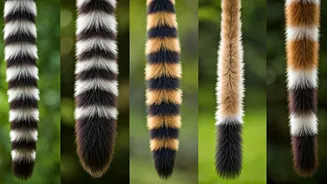Monkey's Prehensile Tail
Monkeys, especially those found in the New World, like the spider monkey and the howler monkey, are renowned for their prehensile tails. These tails act
like an extra limb, providing remarkable agility in the treetops. The prehensile tail allows the monkey to grasp branches, swing effortlessly, and maintain balance as it navigates the forest canopy. Specialized ridges on the underside of the tail enhance grip, giving these primates a secure hold. The tail also helps them to hang from branches, freeing up their hands for eating or other activities. This incredible adaptation is crucial for their arboreal lifestyle and survival.
Leopard's Balancing Act
Leopards, magnificent big cats, use their tails primarily for balance. Their tails are long and muscular, acting as a counterbalance as they stalk prey or leap through their surroundings. The tail helps them maintain stability, especially when maneuvering at high speeds or traversing challenging terrains like rocky hillsides. While the leopard hunts, the tail is used to steady itself during swift turns and jumps. This ability is especially critical when chasing prey or when climbing trees to observe their environment. The length and flexibility of the tail further enhance this balancing function, enabling these big cats to move with grace and precision.
Squirrel's Bushy Defense
Squirrels possess a bushy tail that serves multiple functions, including defense. The tail acts like a warm blanket in cold weather. Additionally, it helps to confuse predators. The bushy tail can create a visual distraction, potentially allowing the squirrel to escape if attacked. This tail aids in balancing when leaping from branch to branch. The tail also acts as a signal to other squirrels, conveying messages of danger or territory. Furthermore, the squirrel’s tail can also be used as a sunshade to protect from the sun, making it useful in different weather conditions.
Scorpion's Venomous Sting
Scorpions, with their formidable tails, use them primarily for defense and hunting. Their tails house a venomous stinger. This stinger is employed to inject venom into prey, paralyzing or killing it, making it easier to consume. The stinger is also a vital defense mechanism against predators. When threatened, a scorpion can quickly curve its tail forward to deliver a potent sting. The type of venom varies among scorpion species, but the primary purpose of the tail remains consistent: survival. The tail and stinger are key to a scorpion’s survival, allowing it to hunt, protect itself, and thrive in its environment.
Peacock's Display Beauty
Peacocks showcase vibrant, elaborate tails, especially the male peacocks. These stunning tail feathers serve a primary purpose: attracting mates. The elaborate display is a show of the peacock's genetic fitness. The more vibrant and impressive the tail, the more likely the peacock is to win a mate. The peacock’s tail does have a small practical function, helping stabilize the bird during flight. The evolution of such a conspicuous and at times cumbersome feature shows the power of sexual selection, where traits that enhance reproductive success are favored, even if they pose some survival disadvantages. The peacock tail, therefore, demonstrates beauty's function in nature.





